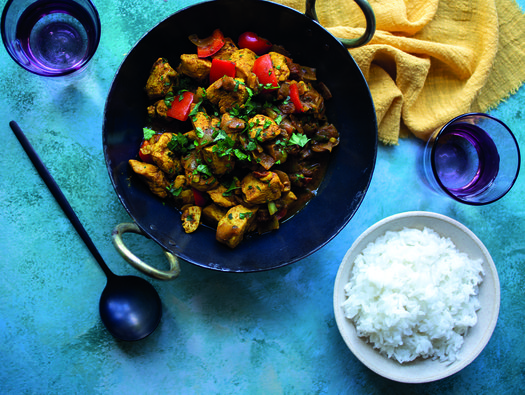Chicken jalfrezi

Using spices and making your own curry paste adds plenty of flavour without the salt.

Using spices and making your own curry paste adds plenty of flavour without the salt.
240g Basmati rice
2 small onions
4 garlic cloves
1 inch piece of fresh ginger
2 tablespoons vegetable oil
2 medium tomatoes
2-4 green chillies (depending on how spicy you want it)
½ teaspoon ground turmeric
1 ½ teaspoons ground coriander
1 teaspoon ground cumin
2 teaspoons red chilli powder
500g chicken breast, skinless
1 red pepper
30g fresh coriander
1 teaspoon garam masala powder
125-250ml water
Rinse rice under running water for 10 seconds. Drain, pour into a bowl, cover with cold water. Soak for 30 minutes.
Heat the oil in a large, non-stick saucepan over a medium heat. Add the onions and stir for 3 minutes until translucent. Add the chopped ginger and garlic and cook for a further 2 minutes.
Add the chopped chillies and tomatoes, followed by turmeric, coriander and chilli powder and stir well. Add 50ml of water and cook for 5 minutes
Add the chicken breast pieces to the pan and cook for 15 minutes, stirring occasionally. Add a splash more water, if needed to stop it sticking. While the chicken is cooking, drain the rice using the sieve. Bring a saucepan of water to the boil, then add the drained rice. Cover and simmer for 10 minutes.
Once the chicken is cooked, add the red pepper pieces to the curry pan with another 125ml of water. Cover and simmer for 5 minutes. Add most of the chopped coriander leaves to the curry (reserving a handful to garnish when serving), followed by the garam masala powder. Simmer for 2 minutes for the flavours to combine.
Once cooked, drain the rice. Serve the curry and rice together and garnish with chopped coriander leaves.
The rice is the main source of carbohydrate in this dish and the values have been provided for those who have trained in insulin adjustment.
There are no additives or processed ingredients in this dish which helps to keep it low in potassium and phosphate. If you have been prescribed a phosphate binder, ensure you take them with this dish.
Chicken is a good source of protein and this curry would therefore be a good choice if you receive dialysis treatment. If you have been advised to follow a low protein diet you could halve the amount of chicken used.
Remove the chicken for a vegetarian dish.
To reduce the amount of fat, try using a non-stick frying pan with a small amount of spray oil instead of the vegetable oil.
We don’t recommend that rice is reheated, however the curry can be kept in a fridge in an airtight contained for two days or cooled and frozen for up to three months. Reheat thoroughly before eating.
For an authentic fragrant curry, you can buy fresh whole spices from local supermarkets or south Asian grocers and grind these at home using a coffee grinder. The spices will retain the aroma and last longer.
When chopping the chillies, keep the seeds in if you want more heat.
If you are from South Asian origin and have been diagnosed with chronic kidney disease (CKD), culturally appropriate diet and lifestyle advice from your kidney dietitian will help you enjoy the food you love safely, and in ways that will keep you well.
You can enjoy a wide variety of delicious and healthy food when you are living with kidney disease. All Kidney Kitchen recipes are analysed and approved by kidney dietitians. Search through our kidney-friendly recipes or filter them by category below.
This dish is a traditional family recipe from the Bengal Coast. A wonderful use of spices makes this dish a flavourful meal that’s low in salt, potassium and phosphate.
By giving us your email address, you're giving us permission to send you the latest news from Kidney Care UK. Further information about how we protect and use your personal data is available in our Privacy policy. If you would like to change the way we communicate with you at any time please email [email protected]. You can unsubscribe at any time by using the link at the bottom of every email we send.